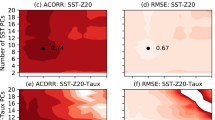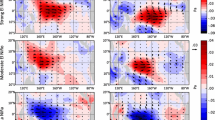Abstract
Prediction models of the El Niño-Southern Oscillation (ENSO) phenomenon often represent westerly wind bursts (WWBs), a significant player in ENSO dynamics, as stochastic forcing. A recent paper developed an observationally motivated semi-stochastic statistical model that quantifies the dependence of WWBs on large-scale sea-surface temperature. This WWB model is added here to a hybrid coupled model, thus activating a two-way SST-WWB feedback. The WWB model represents both the deterministic and stochastic elements of WWBs and thus is especially appropriate for ensemble ENSO prediction experiments. An ensemble of retrospective forecasts is performed for the years 1979–2002. Overall statistical measures of predictability are neither degraded nor improved relative to the hybrid, coupled general circulation model, perhaps because of the limitations of the hybrid coupled model and the initialization procedure used. While the present work is meant as a proof-of-concept, it is found that the addition of the WWB model does improve the prediction of the onset and the development of the large 1997 warm event, pointing to the potential for ENSO prediction skill improvement using this approach.




Similar content being viewed by others
References
Batstone C, Hendon HH (2005) Characteristics of stochastic variability associated with ENSO and the role of the MJO. J Climate 18(11):1773–1789
Chang P, Ji L, Wang B, Li T (1995) On the interactions between the seasonal cycle and El Niño-Southern Oscillation in an intermediate coupled ocean-atmosphere model. J Atmos Sci 52:2353–2372
Eisenman I, Yu LS, Tziperman E (2005) Westerly wind bursts: ENSO’s tail rather than the dog? J Climate 18(24):5224–5238
Fasullo J, Webster P (2000) Atmospheric and surface variations during westerly wind bursts in the tropical western Pacific. Q J R Meteorol Soc 126(564):899–924
Gebbie G, Eisenman I, Wittenberg A, Tziperman E (2007) Modulation of westerly wind bursts by sea surface temperature: a semistochastic feedback for ENSO. J Atmos Sci 64(9):3281–3295. doi:10.1175/JAS4029.1
Gebbie G, Tziperman E (2008) Predictability of SST-modulated westerly wind bursts. J Climate (submitted). Available at http://www.seas.harvard.edu/climate/gebbie/pubs/gebbie_wwbmodel.pdf
Griffies SM, Harrison MJ, Pacanowski RC, Rosati A (2003) A technical guide to MOM 4. NOAA/ Geophysical Fluid Dynamics Laboratory, Princeton, NJ, USA 08542. Available online at www.gfdl.noaa.gov
Griffies SM, Pacanowski RC, Schmidt M, Balaji V (2001) Tracer conservation with an explicit free-surface method for z-coordinate ocean models. Mon Weather Rev 129(5):1081–1098
Harrison MJ, Rosati A, Soden BJ, Galanti E, Tziperman E (2002) An evaluation of air-sea flux products for ENSO simulation and prediction. Mon Weather Rev 130(3):723–732
Jin F-F, Lin L, Timmermann A, Zhao J (2007) Ensemble-mean dynamics of the ENSO recharge oscillator under state-dependent stochastic forcing. Geophys Res Lett (submitted)
Kerr RA (1999) Atmospheric science: does a globe-girdling disturbance jigger El Niño? Science 285(5426):322–323
Landsea CW, Knaff JA (2000) How much skill was there in forecasting the very strong 1997-98 El Niño? Bull Am Meteorol Soc 81(9):2107–2119
Large W, McWilliams JC, Doney SC (1994) Oceanic vertical mixing: a review and model with nonlocal boundary layer parameterization. Rev Geophys 32:363–403
Lengaigne M, Boulanger JP, Menkes C, Madec G, Delecluse P, Guilyardi E, Slingo J (2003) The March 1997 westerly wind event and the onset of the 1997/98 El Niño: understanding the role of the atmospheric response. J Climate 16(20):3330–3343
McPhaden MJ (2004) Evolution of the 2002/03 El Niño. Bull Am Meteorol Soc 85(5):677–695
McPhaden MJ, Taft BA (1988) Dynamics of seasonal and intraseasonal variability in the eastern equatorial Pacific. J Phys Oceanogr 18(11):1713–1732
Perez CL, Moore AM, Zavala-Garay J, Kleeman R (2005) A comparison of the influence of additive and multiplicative stochastic forcing on a coupled model of ENSO. J Climate 18(23):5066–5085
Picaut J, Masia F, DuPenhoat Y (1997) An advective-reflective conceptual model for the oscillatory nature of the ENSO. Science 277:663–666
Roulston MS, Neelin JD (2000) The response of an ENSO model to climate noise, weather noise and intraseasonal forcing. Geophys Res Lett 27(22):3723–3726
Sweeney C, Gnanadesikan A, Griffies SM, Harrison MJ, Rosati AJ, Samuels BL (2005) Impacts of shortwave penetration depth on large-scale ocean circulation and heat transport. J Phys Oceanogr 35(6):1103–1119
Tziperman E, Yu L (2007) Quantifying the dependence of westerly wind bursts on the large-scale tropical Pacific SST. J Climate 20(12):2760–2768
Vecchi G, Wittenberg AT, Rosati A (2006) Reassessing the role of stochastic forcing in the 1997-98 El Niño. Geophys Res Lett 33:L01706. doi:10.1029/2005GL024 738
Vitart F, Balmaseda MA, Ferranti L, Anderson D (2003) Westerly wind events and the 1997/98 El Niño event in the ECMWF seasonal forecasting system: a case study. J Climate 16(19):3153–3170
Wittenberg AT (2002) ENSO response to altered climates. PhD thesis, Princeton University, 475 pp
Wittenberg AT, Rosati A, Lau N-C, Ploshay JJ (2006) GFDL’s CM2 global coupled climate models. Part III: tropical pacific climate and ENSO. J Climate 19:698–722
Yu L, Weller RA, Liu TW (2003) Case analysis of a role of ENSO in regulating the generation of westerly wind bursts in the Western Equatorial Pacific. J Geophys Res 108(C4). doi:10.1029/2002JC001 498
Zavala-Garay J, Zhang C, Moore AM, Kleeman R (2005) The linear response of ENSO to the Madden-Julian oscillation. J Climate 18(13):2441–2459
Acknowledgements
This work was funded by the NSF Climate Dynamics program, grant ATM-0351123, NSF climate dynamics ATM-0754332, NASA (ECCO2 project). ET thanks the Weizmann Institute for the hospitality during parts of this work.
Author information
Authors and Affiliations
Corresponding author
Rights and permissions
About this article
Cite this article
Gebbie, G., Tziperman, E. Incorporating a semi-stochastic model of ocean-modulated westerly wind bursts into an ENSO prediction model. Theor Appl Climatol 97, 65–73 (2009). https://doi.org/10.1007/s00704-008-0069-6
Received:
Accepted:
Published:
Issue Date:
DOI: https://doi.org/10.1007/s00704-008-0069-6




